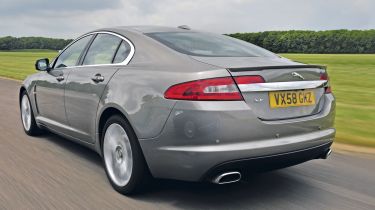Jaguar XF Luxury 3.0D
Acclaimed all-rounder continues to make strong case for itself
How do you improve on perfection? That was the question facing Jaguar this year, because the British manufacturer’s XF saloon currently reigns supreme in the executive market. In 2008 it scooped our prestigious Car of the Year award, and in April it was named the overall champion
in our Driver Power 2009 owner satisfaction survey.
To cement its place at the top of the heap, the prestige brand has introduced a pair of diesel engines to replace its old 2.7-litre unit. The new 3.0 powerplant is available in 238bhp and 271bhp forms – and going up against the E-Class is the lower-output version in Luxury specification.
Nothing has changed on the outside, but that’s no problem as the handsome Jaguar is already one of the most distinctive cars in its class. A contoured bonnet and pronounced haunches give the XF a taut and muscular stance.
It continues to put the Mercedes in the shade on the inside as well. Climb aboard and the red starter button pulses, as if the car has its
own heartbeat. Press it and the theatrics continue as the rotary gearshifter rises from the centre console and the air vents rotate to their open position in unison. It’s all done with real panache and provides a genuine sense of occasion for every trip.
Used - available now

2024 Kia
EV6
20,097 milesAutomaticElectric
Cash £26,300
2023 Audi
e-tron Sportback
54,038 milesAutomaticElectric
Cash £22,600
2019 Mercedes
GLC Coupe
59,484 milesAutomaticPetrol2.0L
Cash £21,000
2025 Audi
A1 Sportback
35,501 milesManualPetrol1.0L
Cash £16,500Smart interior design and high-quality materials give the Jaguar the edge, but it isn’t a case of style over substance. There’s just as much cabin and boot space as you get in the Mercedes – and split-folding rear seats come as standard.
Under the bonnet, the 238bhp V6 gives the more expensive Jag the advantage – it features two additional cylinders, 70bhp more power and a 100Nm torque boost. There are also parallel sequential turbochargers, and while the 2.1-litre twin-turbo Mercedes punches above its weight, the Jag’s massive 500Nm output delivers a knockout blow.
The British car is faster and more responsive than its competitor, and its slick-shifting six-speed automatic transmission helps provide quieter high-speed cruising.
On challenging roads, the XF really shows its talents. Its supple suspension provides a smoother ride than the lowered set-up fitted to the E220 CDI Sport, even though the Jaguar is more capable in bends.
It has impressive composure, sharper steering and stronger, more positive brakes. Where the big cat loses ground to its rival is on emissions – a key factor in this class. Both of these machines are aimed squarely at company buyers, and the XF’s CO2 output of 178g/km is 24g/km higher than the Mercedes’. That places it in a more expensive tax band, forcing drivers earning at the standard rate to fork out an extra £383 annually.
Private buyers have much less to complain about, as the Jaguar will set them back only £25 a year more in road tax. Plus, the XF returned an impressive 33.6mpg in our test – 1mpg more than the smaller-engined E-Class. It also boasts the strongest residual values in its class.
In the final analysis, the more expensive Jag is bigger, faster and better equipped than the Mercedes here. So, does it justify the extra cost?
Details
WHY: Jaguar manages to improve on the already brilliant XF







